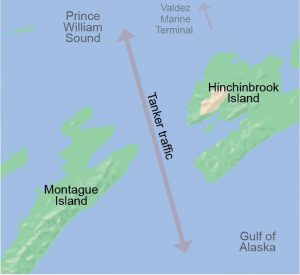When a ship is disabled at sea, an appropriate rescue vessel must respond quickly to prevent an accident. Towing can be dangerous, especially in rough weather, because the rescue tug must get close to connect a towline.
Challenging environment in Alaska

Hinchinbrook Entrance is a narrow waterway that connects Prince William Sound to the Gulf of Alaska. The weather and sailing conditions in the gulf can change rapidly and are often severe.
Tankers carrying millions of gallons of oil regularly pass through the Entrance. Alyeska’s Ship Escort/Response Vessel System must have a tug stationed at the Entrance when laden tankers travel through Prince William Sound.
What is the right tug for this role?
The Council recently asked the experts at Glosten, naval architecture and marine engineering firm, to help answer this question.
Glosten began by reviewing designs and technologies for existing tugs. They summarized the ideal tug design, describing the dimensions, power, propulsor (propeller) types, shape, ability to withstand rough seas, machinery, and towing gear, among other features and equipment.
Glosten then compiled a database of around 4,000 tugs in use around the world. Using the ideal summary as a guide, they narrowed the list to tugs:
- Built in 2005 or later
- Between 130 and 260 feet long
- Able to exert between 130 and 200 tons of pulling or towing power
- Capable of speeds of 18 miles per hour
- Within a reasonable cost to design, build, and operate
Fewer than 400 were left.
Tasks the tug must perform
Glosten then outlined the demands placed on the Hinchinbrook tug at each stage of response. Based on these demands, Glosten concluded a state-of-the-art design for the Hinchinbrook tug must provide exceptional performance in three categories. The ideal tug must be able to maintain these in a broad range of sea states:
- A high free-running speed
- A high degree of maneuverability and agility
- High bollard pull (towing ability) and towing efficiency
After ranking the 400 tugs according to all these features and abilities, they were down to the 17 top scoring tugs.
Finding the right balance
After balancing performance with costs, Glosten determined that the existing vessel most closely matching the needs for an ideal Hinchinbrook tug was the Luz de Mar: a tug operated by Spain’s Maritime Safety and Rescue Society.
The creators of the Luz de Mar designed it for offshore ship rescue and response. This means the Luz de Mar is maneuverable and agile due to a powerful propulsion system, has adequate bollard pull, can aid a disabled tanker in a variety of ways, and is still fast enough for a quick response.
How does the current tug compare?
Glosten studied the differences between the Luz de Mar and the current tug serving Hinchinbrook Entrance, the Ross Chouest.
Their study showed that a tug designed specifically for that role would improve safety and efficiency, improve response times, and reduce the chance of an oil spill.
Conclusion: Purpose-built tugs work better
The researchers noted that many believe the largest and most powerful tugs are ideal for rescue operations. In fact, the design of these larger vessels does not prioritize the features most important to a successful emergency response.
They concluded that a tug designed with this purpose in mind offers significant advantages, especially when a rescue tug works close to shore.
More details
A recent issue of International Tug and Salvage has a more detailed article by Peter Soles of Glosten and Alan Sorum of the Council, available on the magazine’s website: Defining the best technology for emergency rescue tugs
Glosten’s full report: Hinchinbrook Entrance ETV BAT Assessment – Final Report